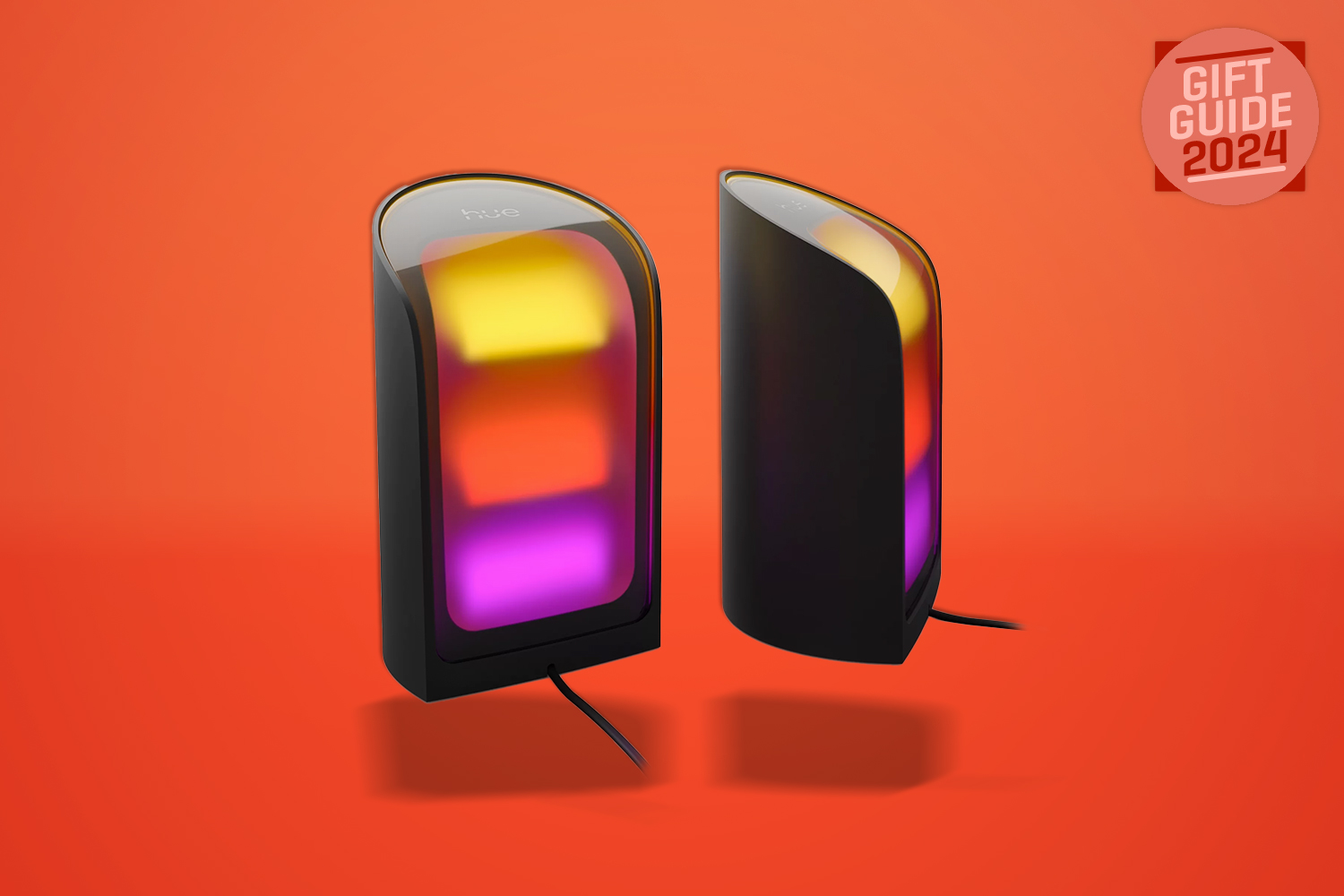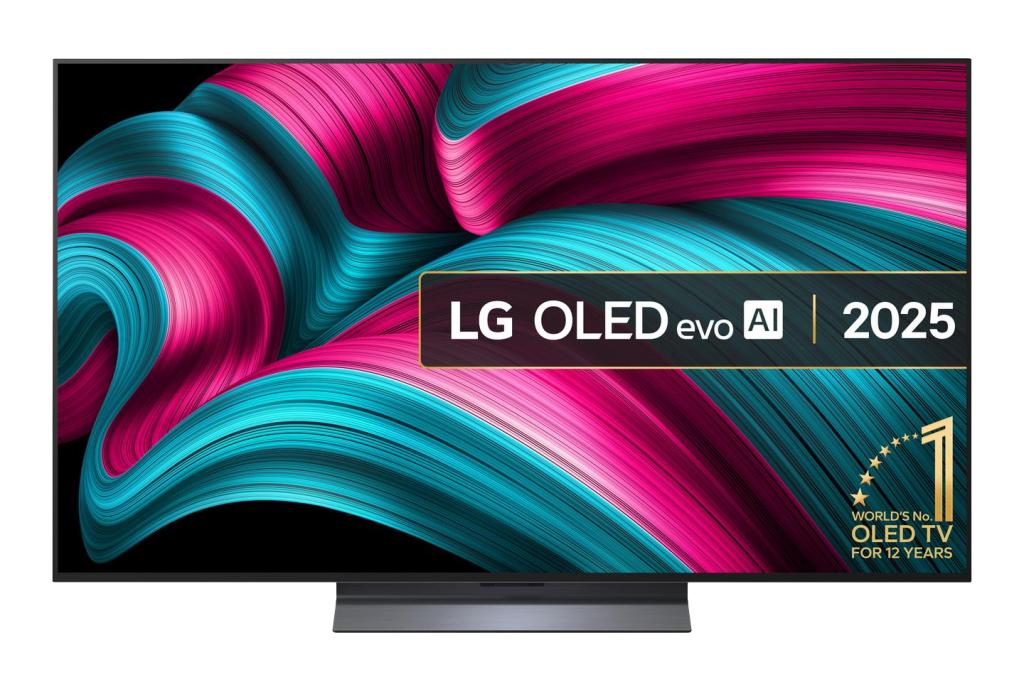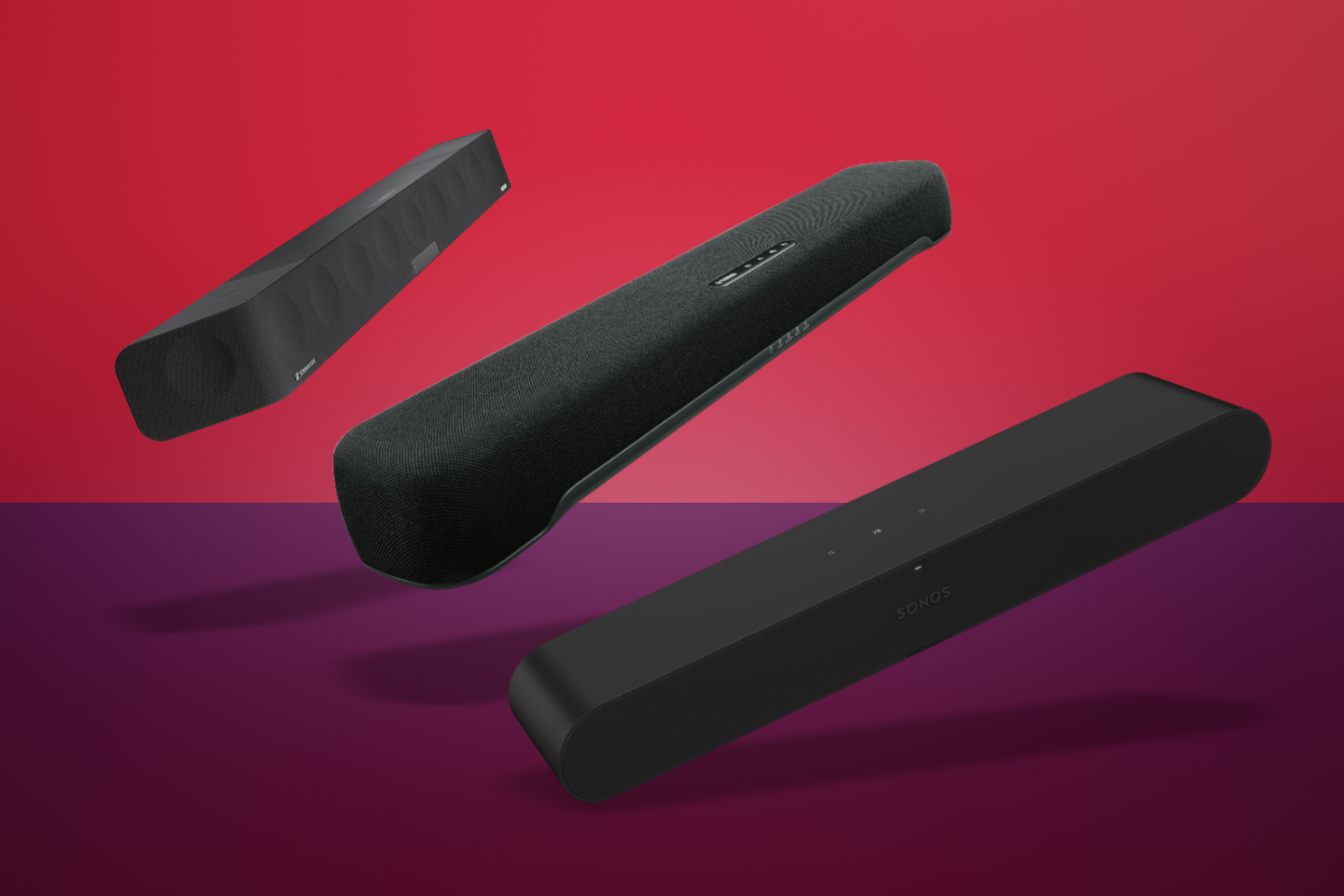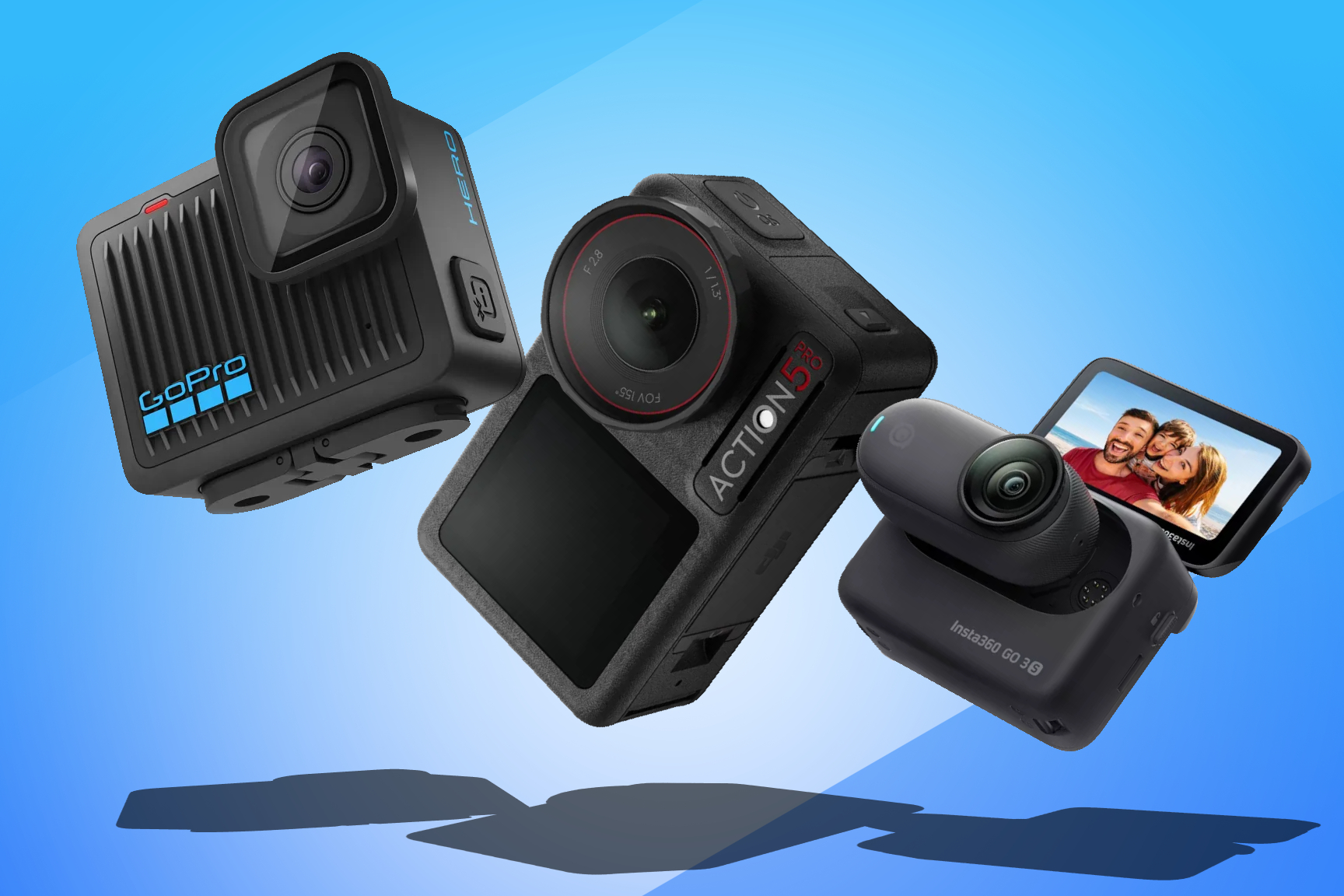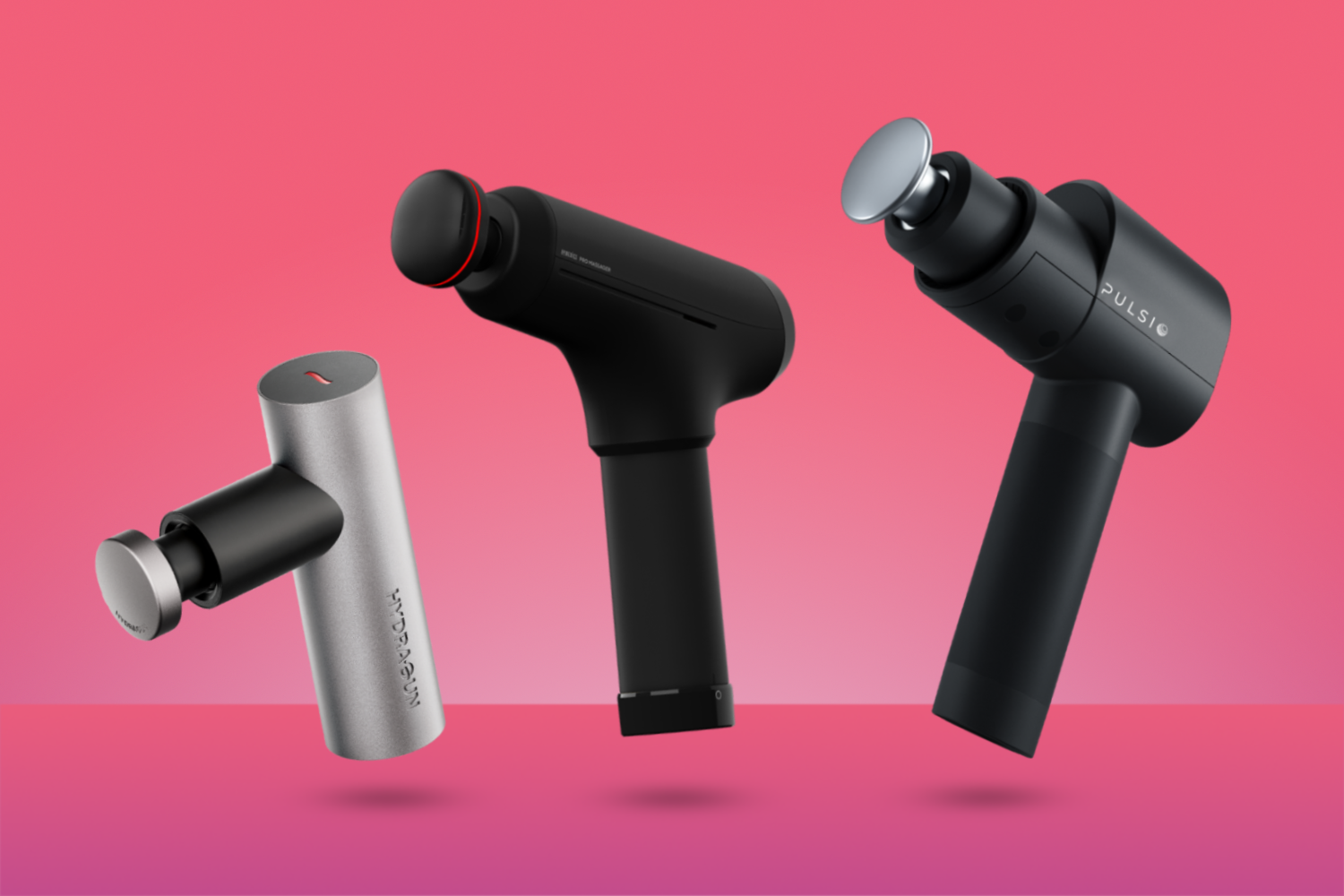Slim TVs might look slick on your living room wall, but they don’t leave much space for speakers. And if there’s one way to ruin movie night, it’s with disappointing audio. Don’t fancy filling your room with surround sound speakers? These contenders for the title of best soundbar deliver beefy bass, room-filling volume and clarity that won’t leave you reading subtitles – all from a single bar that sits neatly beneath your TV.
So, you don’t need a fleet of separates to sort out your subpar sound. Better yet, you don’t have to drop thousands to give your ears an upgrade – although there’s plenty of brilliant gear if your budget does stretch to several zeroes.
So, whether you’re shopping for sound to fill your studio apartment or looking for a soundbar to bring big-screen audio to your massive movie room, the list below features the very best soundbars for every home and price tag. And if you’re looking for a new TV, then check out our best 4K TV guide. It’s also worth keeping in mind that many of these soundbars can pair with the best multi-room wi-fi speakers (as long as they’re compatible) to create a true 5.1 or 7.1 surround sound system.
Why you can trust Stuff: Our team of experts rigorously test each product and provide honest, unbiased reviews to help you make informed decisions. For more details, read how we test and rate products.
Quick list: what is the best soundbar?
The best soundbars you can buy today:
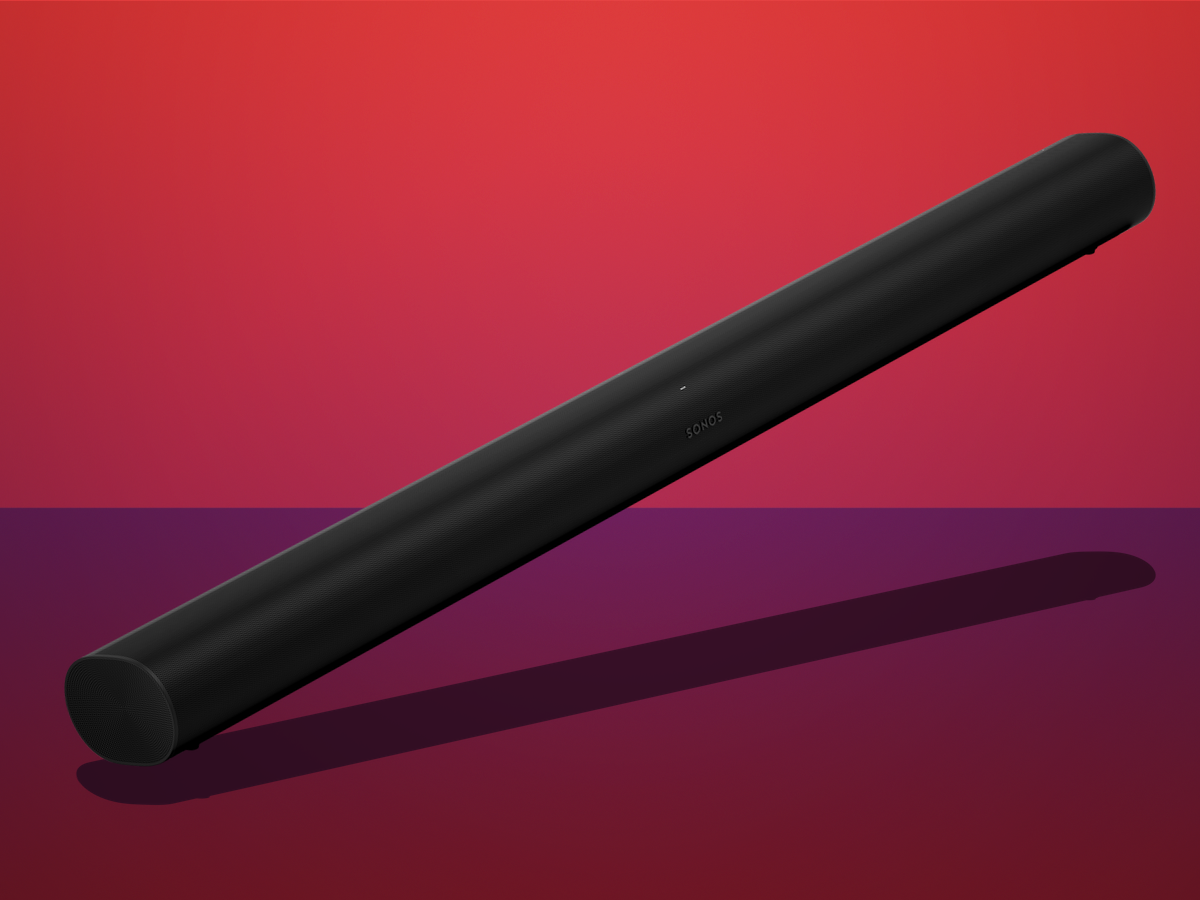
1. Sonos Arc Ultra
| Sonos Arc Ultra specs | |
|---|---|
| Connectivity | eARC HDMI only, Wi-Fi, Bluetooth |
| Format | Dolby Atmos, Dolby True HD, Dolby Digital+, Dolby Digital, DTS |
| Streaming | AirPlay 2, Sonos App |
| Dimensions | 1178 x 110.6 x 75mm, 5.9kg 46.4 x 4.4 x 3 in, 13 lb |
Is there a soundbar easier to recommend to people with money to spend than a Sonos Arc Ultra? Maybe not.
It looks good, it does not take up masses of space under a 55in+ TV. It sounds great flying solo for both music and films, and it slots into the multi-room system better-known than any other. Spoiler: it’s Sonos.
Granted, this was the one soundbar that gave us some minor setup headaches. And since 2024, Sonos’s rep for ease of use isn’t quite what it was. Touching the nearest wooden speaker cabinet we can find, though, we’ve had no issues after that initial setup.
There are no fewer than 14 drivers in this 117cm long home cinema tube, and they are quite the team. You get far better bass than its predecessor the Arc soundbar, and there’s an inviting velvet texture to the mids that does wonders for the presentation of vocals when the entertainment you want is more Tom Waits than Tom Cruise.
Sure, despite clear imaging here, the full Samsung Q990F will smoke this soundbar riding solo with Dolby Atmos tracks. While powerful-sounding, the lack of a separate subwoofer also limits bass depth slightly and means the low-end on tap here can sound just a mite busy at times.
But the beauty of a Sonos soundbar is that you can build it up at your own pace, with a Sonos subwoofer and surrounds. The ugly part is you’ll end up spending a fortune doing so.
That’s really the main consideration here: do you want to buy into a Sonos system? While there’s no obligation to upgrade, the Arc Ultra also has no aux input, or optical, just Wi-Fi, Bluetooth and the eARC HDMI connector.
Don’t be too put off, though, as this is a lively, dynamic and engaging soundbar we’d be happy to make the heart of a home entertainment setup.
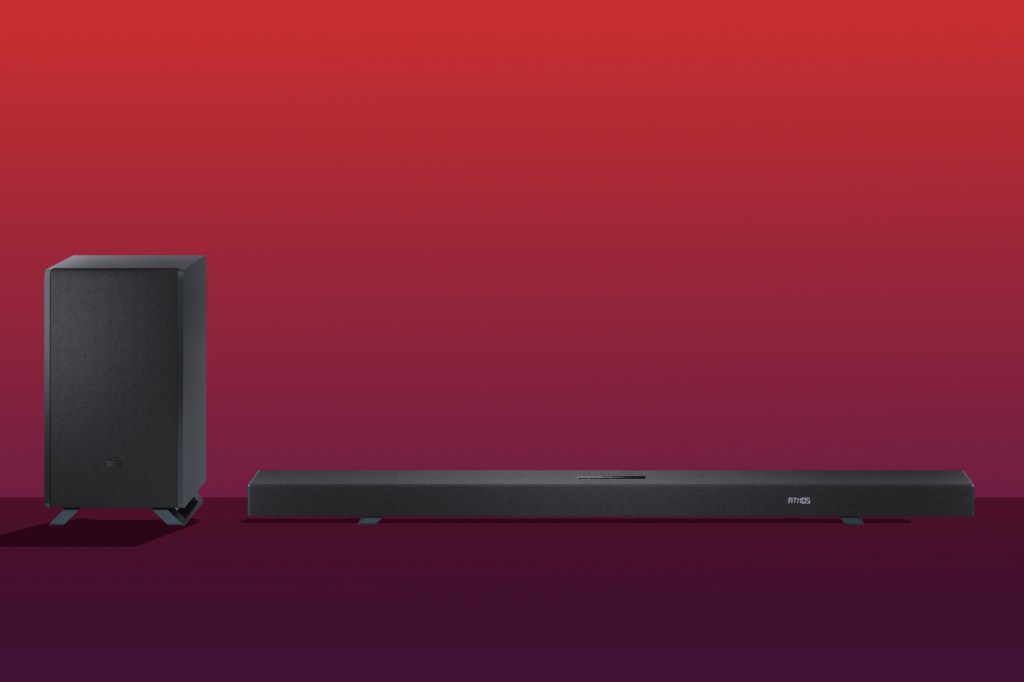

2. Samsung HW-Q990F
| Samsung HW-Q990F specs | |
|---|---|
| Connectivity | eARC, 2x HDMI 2.1 inputs, optical, Wi-Fi, Bluetooth 5.3 |
| Format | Dolby Atmos, DTS:X, Dolby TrueHD, Dolby Digital Plus, Dolby Digital, DTS Digital Surround, DTS-HD High-Resolution |
| Streaming | Google Cast, Spotify Connect |
| Dimensions | 1232 x 70.8 x 138 mm, 7.3kg 48.5 x 2.8 x 5.4 in, 16.1 lb |
Back in 2020 Samsung went and made the best mainstream Dolby Atmos soundbar, the Q900. Five years and several generations of tweaks on, we have the Samsung HW-Q990F. It’s similar, yep, but also still one of the best soundbars in the known universe. And it’s much more than that, too.
The Samsung HW-Q990F is ideal for the person whose inner interior designer (or outer one, perhaps their partner) won’t let them go all out on a separate surround system. Its soundbar is paired with a wireless subwoofer and a pair of compact rear surrounds. This is the full package, and power cables are the only connectors required.
It comprises a frankly ridiculous 23 speakers, including upwards-pointing ones for Dolby Atmos audio, in both the soundbar and the rears. And a dedicated central channel to keep dialogue firmly rooted to your TV. The first impression of sticking the Samsung HW-Q990F on: bliss. There’s a beautifully seamless interplay between the wireless sub and the soundbar. That relationship is so often traded away for cheap rumbly thrills in home cinema gear, but it matters.
Stick on a Hollywood movie, though, and you’ll see what sub-bass feats Samsung’s subwoofer is really capable of. This redesigned unit uses two force-cancelling 8-inch drivers. The result is a small-but-neat sub with a closed design, only half the volume of some on test.
Clarity, separation, imaging and detail are all top-tier in this class. That only improves when you plug in the surround rears, turning the best Atmos mixes into mini universes of sparking sound. That’s the number one win here. The realism of spatial audio versus the amount of room space you sacrifice for it is astounding.
As you’d hope, given the price, the HW-Q990F also provides loads of ways to connect. There’s Wi-Fi for Google Cast or Spotify Connect. Two HDMI 2.1 inputs in addition to the core eARC HDMI give you an insurance policy if your TV isn’t quite as up-to-date on audio formats as this soundbar. There’s Bluetooth, and onboard mics let you speak to Alexa directly if you like. That mic array will fine-tune the sound for your room automatically in the clever SpaceFit Sound Pro mode too.
And there are a couple of modes for those keen not to tick off their neighbours too much. As well as the smaller-sounding Night mode, Moderate Bass feeds all the low-end through the bar, effectively turning off the subwoofer. It can really help in avoiding thunderous bass going straight through the floor without totally neutering your sound.
Complaints? Samsung’s style dollops on a little less sugary gloss than Sonos, leading to perhaps slightly cool and lean-sounding mids. Real similarity with the last generation means you could accuse Samsung of playing it too conservative. And the aggressively ridged, sharp-sided soundbar shape may not be to all tastes. In summary? Samsung hasn’t really put a foot wrong.
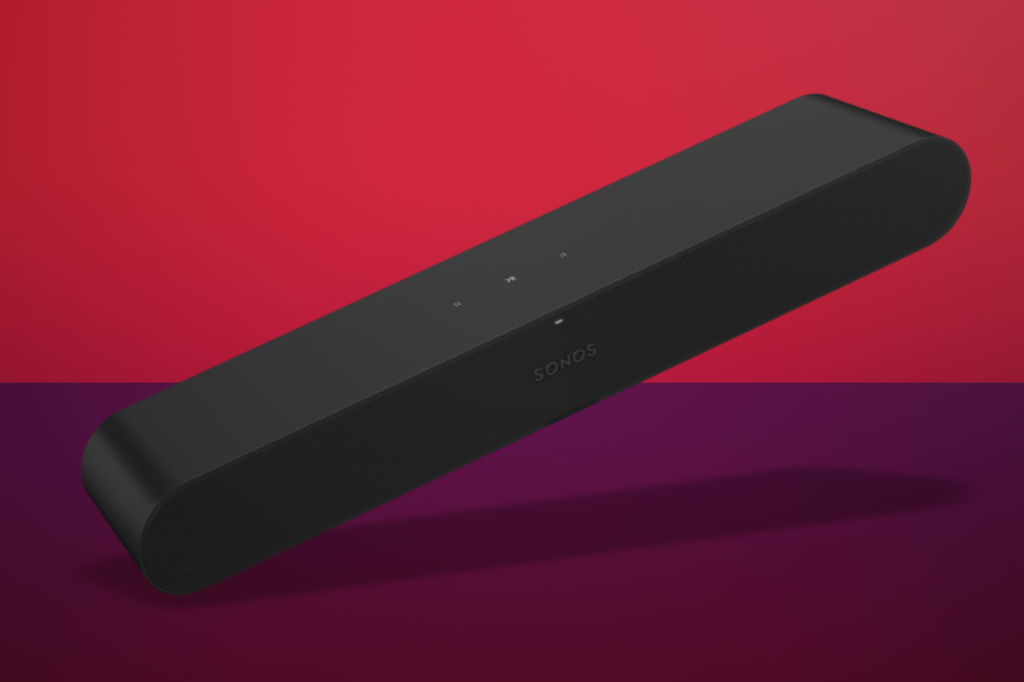

3. Sonos Ray
| Sonos Ray specs | |
|---|---|
| Connectivity | Optical, Ethernet, IR receiver |
| Format | Stereo PCM, Dolby Digital 5.1, DTS Digital Surround |
| Streaming | Sonos app Wi-Fi, AirPlay 2 |
| Dimensions | 55.9 x 9.5 x 7.1 cm, 1.95kg 22 x 3.7 x 2.8 in, 4.3 lb |
Squeezing multi-room smarts into a compact bar, the Ray is a tempting accessory for owners of other Sonos speakers. Bearing the usual hallmarks and styling cues of Sonos kit, the Ray’s premium build belies its relatively accessible price tag.
Networking is via Wi-Fi or Ethernet, but there’s no HDMI here: the Ray relies on optical for talking to your telly. This is simple enough but can cause issues when trying to control the bar with your TV remote. Setup is through the Sonos app, which includes using your smartphone’s mic to automatically adjust acoustic output to suit your viewing room.
Four amps, two tweeters and two mid-woofers work together with a bass reflex system to fill most spaces with forward-firing sound. Quality is predictably superb, trumping some bigger bars and coping well with busy scenes. That said, there’s no Dolby Atmos, and you’ll want something beefier if your living room is larger than average.
Voice assistant support requires a separate smart speaker, while music streaming means making use of the Sonos app or AirPlay 2: annoyingly, there’s no Bluetooth option. Still, effective sound modes – including Speech Enhancement – and clever connectivity make this a smart choice for Sonos owners.


4. Marshall Heston 120
| Marshall Heston 120 specs | |
|---|---|
| Connectivity | eARC, HDMI input, RCA, sub, USB-C, Ethernet, WiFi, Bluetooth 5.3 |
| Format | Stereo PCM, Dolby Digital 5.1, DTS Digital Surround |
| Streaming | Spotify Connect, TIDAL Connect, Google Cast, AirPlay |
| Dimensions | 1100 x 145 x 76mm, 7.04kg 43.3 x 5.7 x 3.0 in, 15.5 lb |
The Heston 120 is Marshall’s first-ever soundbar. And it doesn’t come out of the blue. Marshall guitar amps may have a longer legacy (est. 1962), but we’ve also had Marshall speakers and headphones for 15 years now. Cripes, we’re getting old.
This soundbar’s look has to be its number one draw. The Marshall logo sits up front, the brand’s signature gold highlights set against the tough-looking woven grey fabric of the outer. It’s dripping in classed-up Marshall sauce.
In another against-the-grain move, the Heston 120 doesn’t use a remote. That would be a waste of the chunky amp-style controls on the top. You can, of course, use your TV remote too, though, at least when plugged in over HDMI ARC. There’s no digital assistant nonsense either, which we imagine some old-school Marshall fans will love. Classic RCA inputs let you plug in sources from the pre-streaming era, too.
With all the nods to the past, the Heston 120 is also made for today. It’s an 11-driver Dolby Atmos-ready soundbar with dedicated upwards-firing height drivers. Add that to side-firing speakers and you have a recipe for real spatial audio ability. The bass is what left the strongest impression on us, though. Low-end power is obviously great for movies, but also lends rock kick drums the power they need.
How could Marshall make a soundbar without giving it rock music chops? We don’t think this one is begging for a subwoofer, but one is coming from Marshall, and you can even use your own, as the soundbar has a wired sub output.
Once again, it’s old and new coming together. Those who have gone fully wireless are sorted too, as the Wi-Fi lets you use Spotify Connect, TIDAL Connect, Google Cast and AirPlay.
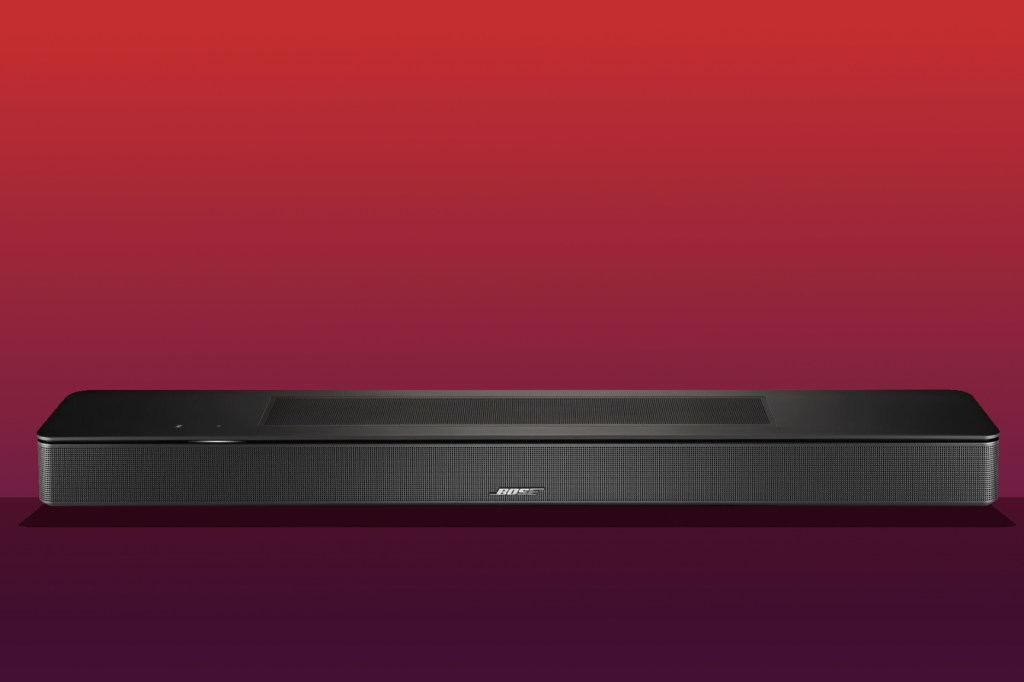

5. Bose Smart Soundbar 600
| Bose Smart Soundbar specs | |
|---|---|
| Connectivity | HDMI eARC, optical, subwoofer, Wi-Fi, Bluetooth 4.2 |
| Format | Dolby Atmos, Dolby TrueHD, Dolby Digital Plus, Dolby Digital |
| Streaming | Wi-Fi, Bluetooth 4.2, AirPlay 2, Chromecast built-in, Spotify Connect, Bose Music app, Alexa Cast, Amazon Alexa, Google Assistant |
| Dimensions | 694 x 104 x 56mm, 3.2kg 27.3 x 4.1 x 2.2 in, 7.1 lb |
The Bose Smart Soundbar has a party trick. It sounds way larger than it looks, ideal for those who don’t have enormous TVs or loads of free space. At less than 70cm long, this bar is around the width of a 40in TV, not today’s 55-inch norm. Despite that, its soundstage is significantly wider and taller than most in this test.
Getting expansive and dynamic sound out of a relatively small box is this thing’s calling card. And while Bose’s decades-long experience in psychoacoustics no doubt has a part to play, a lot of it is down to good old speakers. Its drivers pump out sound from the side and upwards from the top, as well as from the front. The soundbar even does a decent job with Dolby Atmos content, providing spatial imaging better separated and clearer than that of soundbars that take up three times the cubic centimetres in volume.
Bose’s tuning gives real articulation to the mid-range, which makes dialogue super-clear. And if you need some next-level help when listening to those Christopher Nolan movies, there’s an AI dialogue booster mode. The Smart Soundbar continues sounding alive and dynamic at low volumes, further growing its appeal for folks who just can’t fit in a separate subwoofer or a plus-size soundbar. There are compromises, of course.
There’s a clear limit to the bass. While this soundbar sounds full, it gives up long before hitting the sub-bass stuff that threatens the integrity of your double glazing. Those million-dollar movie action sequences still have heft, but for bass you can feel in your chest, you’ll need to get Bose’s add-on Bass Module 500 or 700.
The part that gives us slight pause, though, is something else. This soundbar has a slight synthetic or artificial edge to its tone, texture, timbre — take your pick. This becomes clear when you compare it to another half-decent soundbar, and means we don’t flat-out love this one for music.
Still, before you instantly jump to the similarly priced Sony, you need to consider the features you get here. This is a fully tooled-up soundbar. It has Wi-Fi as well as Bluetooth. You can use Spotify Connect or Google Cast to directly send music to the bar.
It can be grouped up with other Bose speakers to become part of a full multi-room setup. This is done through the Bose phone app, which also provides access to surprisingly comprehensive sound controls. Above the usual bass and treble tweaks, you can control the height and central channels independently. It’s particularly handy when the Smart Soundbar uses Bose’s TrueSpace tech to upscale plain old stereo content to use all the spatial channels it has at its disposal. There’s even a microphone array that lets you talk to Alexa.
If you want a Bose for its famed ease of use, fear not. You can forget all modes, all customisations. The bundled remote is as simple as they come, and there’s a clear set of volume indicator LEDs under the grille. It’s all you really need.


6. Denon Home 550
| Denon Home 550 specs | |
|---|---|
| Connectivity | HDMI, optical, USB, ethernet, 3.5 AUX |
| Format | Dolby Atmos, DTS:X, Hi-Res Audio |
| Streaming | Wi-Fi, Bluetooth, Google Assistant, Siri, Alexa, Spotify, AirPlay 2 |
| Dimensions | 65.9 x 7.4 x 12 cm, 3.33 kg 25.9 x 2.9 x 4.7 in, 7.3 lb |
Link the Beam (Gen 2), Denon’s Home 550 is a usefully compact soundbar with some Dolby Atmos support. Just the right size to sit beneath a 40-55in TV, it’s both discreet and sophisticated. Its plastic shell is nothing special, but the unit is well-built and finished with a neat acoustic cloth.
As well as DTS:X and Dolby Atmos, the Home 550 can handle full-fat high-res audio – handy if you’re subscribed to a premium streaming service, which you can integrate through the useful HEOS smartphone app.
Sonic services are provided by a pair of 19mm tweeters, four 55mm full-range drivers and three passive radiators. Like the Sonos Beam (Gen 2), none of these point upwards, so the Home 550 relies on algorithms to produce a 3D effect. This is impressive, up to a point: the bar delivers a big sound with noticeable height, showing good dynamic potency and plenty of detail across the frequency range. Bass is deep but controlled, too.
Turn it up and a lot of that quality is compromised, with the Denon losing its poise and composure at higher volumes. But as long as you listen at sensible levels, the Home 550 is a good-looking and likeable soundbar.
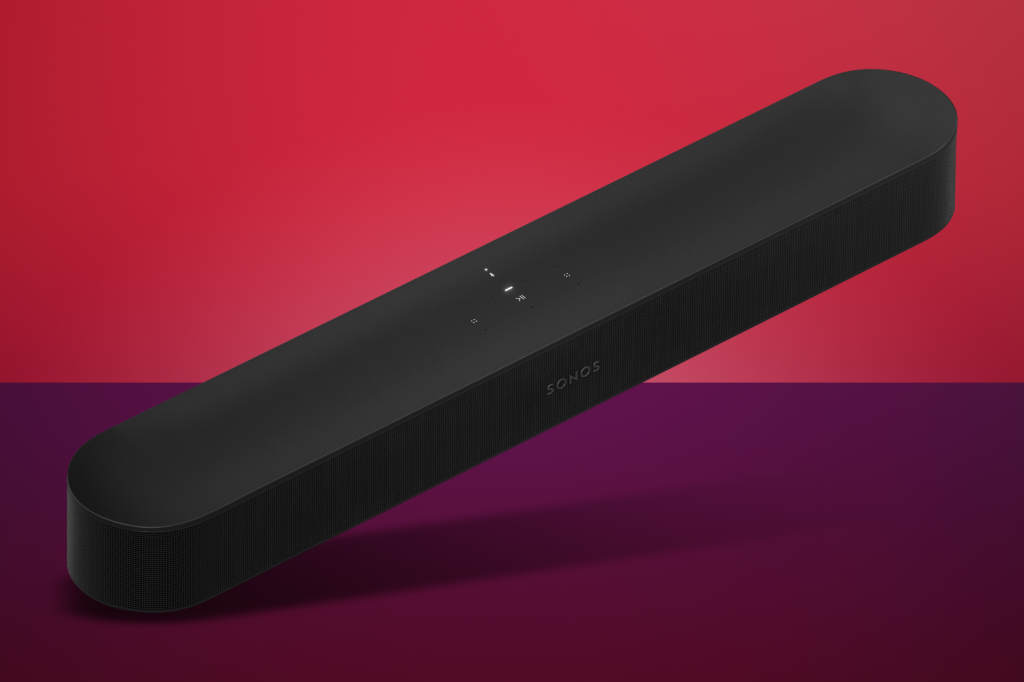

7. Sonos Beam (Gen 2)
| Sonos Beam (Gen 2) specs | |
|---|---|
| Connectivity | HDMI, optical, ethernet |
| Format | Dolby Digital, Dolby Digital Plus, Dolby Atmos, Dolby TrueHD, DTS Digital Surround |
| Streaming | Wi-Fi Sonos app, AirPlay 2, Amazon Alexa, Google Assistant |
| Dimensions | 6.9 x 65.1 x 10 cm, 2.8kg 2.7 x 25.6 x 3.9 in, 6.2 lb |
It’s not the biggest soundbar around, but the Beam is still a winner for most living rooms. Low enough to fit beneath the majority of TVs, the second-gen Sonos is set apart from its predecessor only by the polycarbonate grille which replaces the fabric finish of the first edition. Otherwise, it’s visually the same understated slab.
Despite its compact proportions, the Beam (Gen 2) benefits from many sonic smarts. While just a single HDMI port resides in the rear input array, it’s an eARC number – which means it has the bandwidth for Dolby Atmos.
With the same acoustic architecture as the first version, the updated Beam doesn’t have upward-firing speakers for full Atmos immersion. But thanks to psychoacoustic techniques used across five speaker arrays, it does a deft job of replicating overhead effects. Paired with an impressively expansive soundstage, the Beam (Gen 2) is a small but effective solution for superior sound – and you can always add a Sub if you want more whump.
Need more help deciding which Sonos to buy? Read Stuff’s guide to the best Sonos speakers.
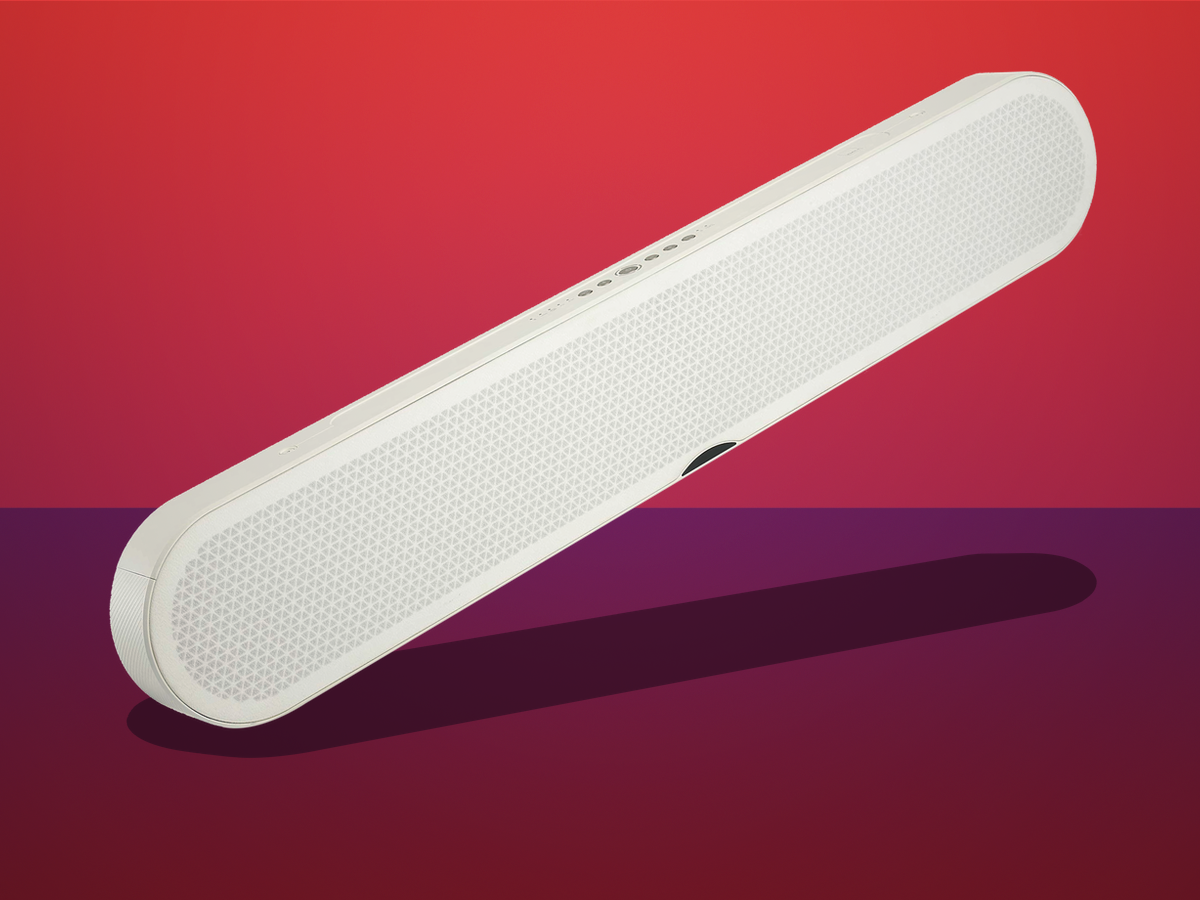

8. Dali Katch One
| Dali Katch One specs | |
|---|---|
| Connectivity | HDMI, 2x optical, 3.5mm AUX |
| Format | N/A |
| Streaming | Bluetooth |
| Dimensions | 16.4 x 86 x 7cm, 3.7kg 6.5 x 33.9 x 2.8 in, 8.2 lb |
Not every soundbar has to look like, well, a soundbar. Case in point: Dali’s Katch One. Styled more like a wireless speaker than a standard audio sausage, it ships in three shades to suit the decor of your movie room.
Equipped with 10 drivers split between front and back, two do tweeter duty, four function as passive radiators and the final quartet are active woofers which deliver punchy bass. Despite the One’s slimline form, 200W of Class D amplification means power isn’t a problem for the natty noise-box.
Sure, you only get two sound modes – and the Katch can’t compete with Atmos units for sheer scale – but you’ll be hard-pushed to find a better-looking soundbar that also delivers the goods. And it’s arguably worth it just for the matching minimalist wall mounts, which hold the One like Art Deco coat hooks beneath your TV.
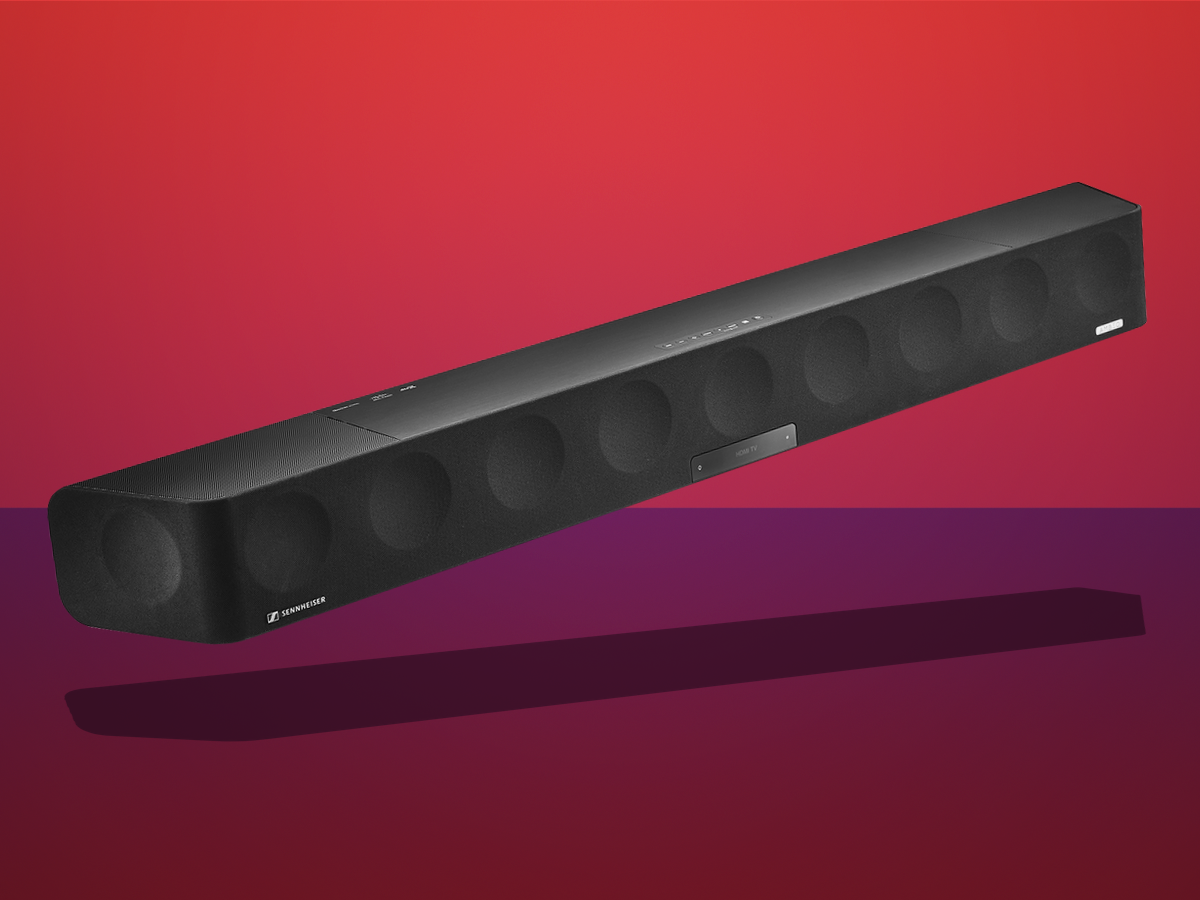

9. Sennheiser Ambeo Max Soundbar
| Sennheiser Ambeo Soundbar specs | |
|---|---|
| Connectivity | HDMI x4, 3.5mm AUX, optical, ethernet, USB |
| Format | Dolby Atmos, DTS:X, LPCM, Dolby Digital Plus, Dolby True HD, DTS 96/24, DSD, MPEG-H, Sony 360 Audio |
| Streaming | Apple Airplay 2, Chromecast, Spotify Connect, Tidal Connect |
| Dimensions | 126 x 13.5 x 17.1 cm, 18.5 kg 49.6 x 5.3 x 6.7 in, 40.8 lb |
Not many people are willing to drop more than $2000/£2000 on their TV, let alone a soundbar to go beneath it. But if you want the absolute best – and have space for something resembling a futuristic railway sleeper – Sennheiser’s Ambeo is the only choice.
At 49.6in / 126cm long and 40.8 lb / 18.5kg heavy, the Ambeo is massive. But it’s big for a reason: there are 13 independent drivers inside: powered by 500W of Class D amplification. Unsurprisingly, it sounds suitably huge. You won’t get better Atmos performance from a soundbar, with individual elements positioned in their own distinct pockets. Everything is balanced and integrated nicely: the top end is sharp but not harsh, voices in the middle have real texture, while the meaty bass is delivered with so much punch that you’d be silly to bother with a separate sub.
Positioning is important for the Ambeo to perform at its full capacity. A mic is included to assist with setup, which calibrates things by listening to a set of test tones. There’s no voice control once you’re up and running, but the Ambeo goes so loud it would probably drown out your instructions anyway.
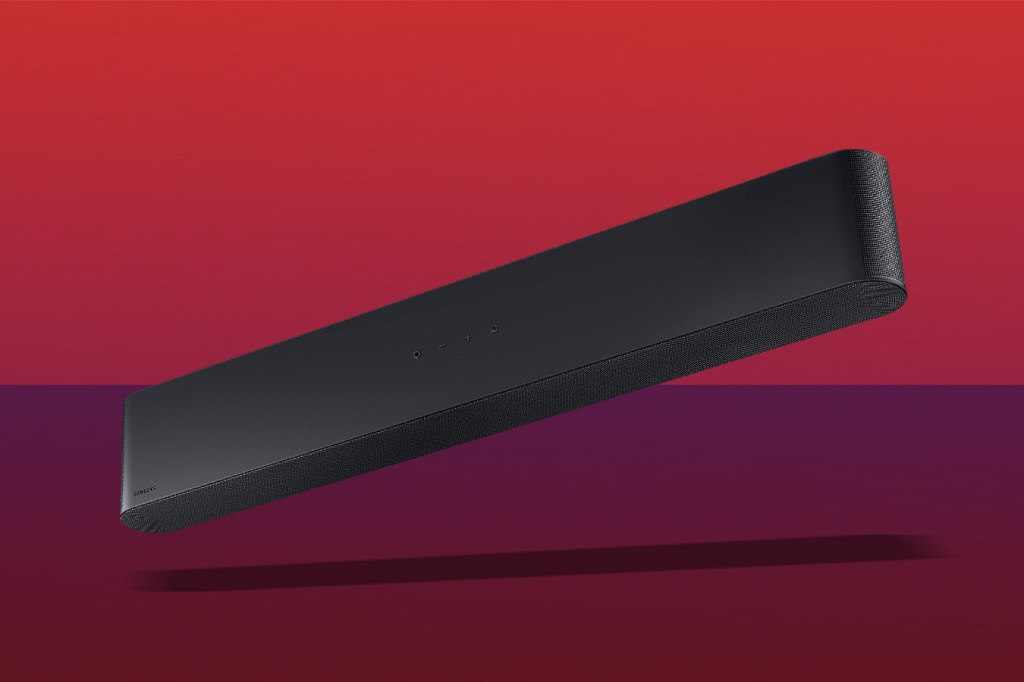

10. Samsung HW-S60B
| Samsung HW-S60B specs | |
|---|---|
| Connectivity | HDMI, digital optical |
| Format | Dolby Atmos, DTS:X |
| Streaming | Wi-Fi, Bluetooth, Apple AirPlay 2, Spotify Connect |
| Dimensions | 670x62x105mm, 2.7kg 26.4 x 2.4 x 4.1 in, 6 lb |
Against the likes of the usual go-to options at this price point (like the oft-mentioned Sonos Beam Gen 2), the Samsung HW-S60B is more of a niche choice, but one with a few key draws. Support for DTS:X, for example, will be welcomed by those with a penchant for physical media. Its wider support in gaming is also something to consider if your console or PC is hooked up to your TV.
If you’re looking for a simple plug-and-play soundbar to boost your regular viewing, you might prefer the Sonos alternative – especially if you’ve already got existing Sonos kit. Alternatively, you could also pick up something like the Sony HT-G700 for the same price. It’s an Atmos/DTS-supporting soundbar that also comes with a sub for beefier bass (though no voice assistant smarts).
Ultimately, you won’t be disappointed with the wider soundscape and punchy audio that the HW-S60B offers. And if you’ve already got a Samsung TV with decent speakers and Q Symphony support, then our recommendation becomes a firm one. The results are something rather unique and impressive, and it makes sense to take advantage of a feature that not everyone will be able to experience.
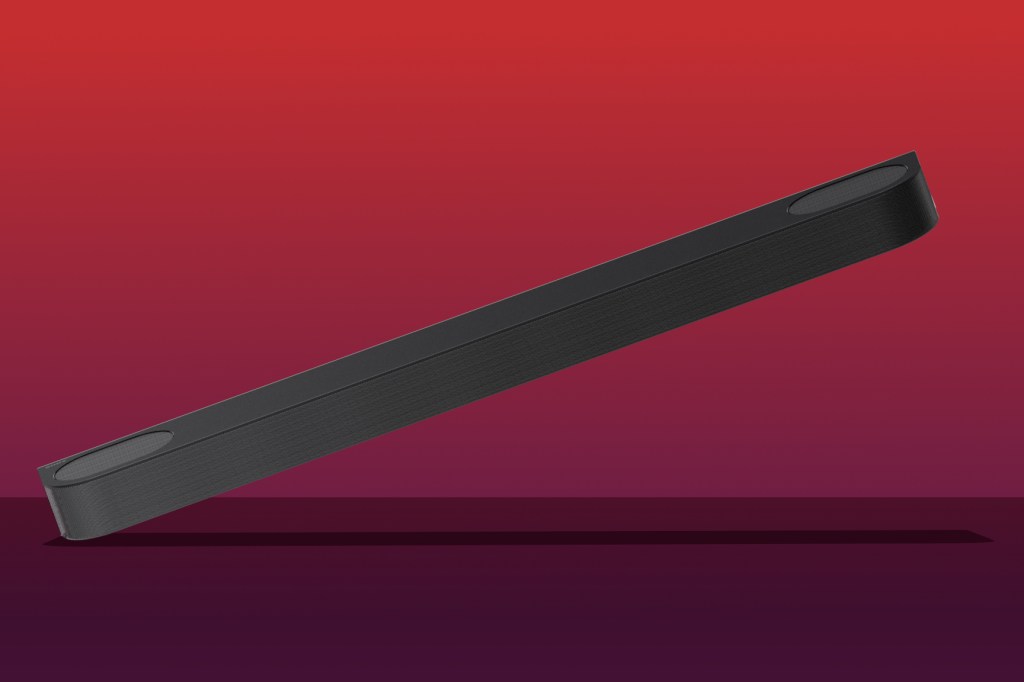

11. Sony Bravia Theatre Bar 6
| Sony Bravia Theatre Bar 6 specs | |
|---|---|
| Connectivity | eARC HDMI, Optical, USB-A |
| Format | Dolby Atmos, DTS:X |
| Streaming | Bluetooth |
| Dimensions | 950 x 110 x 64mm, 3.1kg 37.4 x 4.3 x 2.5 in, 6.8 lb |
In this era of AI being jammed into all sorts of tech, it can seem you end up paying for features you don’t want, never asked for. Sony took the polar opposite approach with the Bravia Theatre Bar 6. It doesn’t cost peanuts, but what you get for the price is impressive, and it’s all good stuff. This is a Dolby Atmos soundbar with proper upward-facing height channel drivers. And as it includes a wireless subwoofer, you can expect far greater low-frequency depth than just about any all-in-one soundbar.
To limbo that all in at under $500 / £450, Sony has removed all the fluff. Including bits that some of you might want. Wi-Fi? Out. Digital assistant support? You’re laughing. There are no extra HDMI inputs, just the one you use to connect your TV, and an optical input. The Theatre Bar 6 doesn’t even have a display, just a single LED to let you know if it’s connected to Bluetooth or the TV.
The stripped-back strategy helps make the Sony Bravia Theatre Bar 6 a real deal. We’re talking sound per pound, friends. Compared to the rivals at 2-3 times the price, the Theatre Bar can compete fairly well on power and scale. It sounds fantastic, as long as you make one tweak.
Our biggest gripe is that the subwoofer is too bassy by default. It tramples over music and adds boominess to those gruff action hero lines. Thankfully, you can fix it. Set the bass to -3 for movies and TV, -4 for music in the Bravia app. Balance is restored, and it becomes a delight for just about all content.
We also like the look of the soundbar, which is less wide and slicker-looking than most, while a package with added rear speakers is an extra $120/£100. Reasonable.
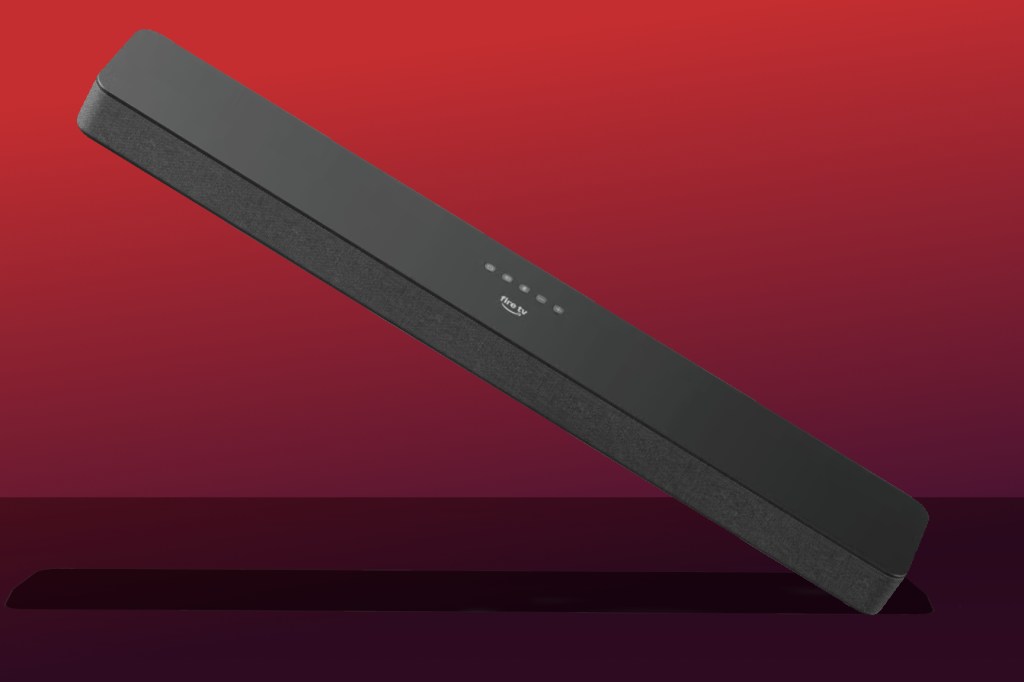

12. Amazon Fire TV Soundbar Plus
| Amazon Fire TV Soundbar Plus specs | |
|---|---|
| Connectivity | eARC HDMI, USB, Optical |
| Format | Dolby Atmos, DTS:X |
| Streaming | Bluetooth |
| Dimensions | 940 x 132 x 64mm, 4kg 37 x 5.2 x 2.5 in, 8.8 lb |
The very best own-brand Amazon gear is near-absurd value for money. The worst is pure trash. This soundbar is part of the first group. Phew. For starters, just look at how big this thing is. At almost a metre long, it’s one of the larger soundbars on test. And while size isn’t everything, the physics of sound matters a lot when you don’t want to spend a billion dollars on R&D.
The Soundbar Plus has three classic pairs of speakers on the front. Three full-range drivers, each paired with a tweeter. And there are two pure bass speakers hidden on the back. Amazon has a lot to appreciate here. Bass depth is better than the twice-the-price Bose soundbar, even delving into the proper rumbly sub-bass region. The standard tuning is solid, and there’s real utility in switching between the Movie and Music sound modes — Movie trades some balance for more bass thrills.
This speaker absolutely nails the basics. It’s clean. It’s clear. It’s natural and goes mega-loud. What it doesn’t do is perform the level of soundstage jiggery-pokery Bose loves. While there’s a surround mode that can slightly extend the width of the sound, without side or up-firing drivers, there are limits to how expansive it can sound.
That puts a big question mark over the Amazon soundbar’s Dolby Atmos support. How do you get that without height channel speakers? You fake it, using virtualisation. It’s better than nothing, but does lead to quite synthetic and digital-sounding effects in Dolby Atmos demos. Don’t expect Atmos bliss, but the sonic strangeness is less noticeable in normal Atmos content.
Next caveat: make sure you know what you actually get before you buy a Soundbar Plus. The focus on getting the basic audio right has led to surprising-to-some cutbacks. This isn’t an Alexa smart speaker. It doesn’t — despite the name — have a Fire TV smart interface baked in.
It’s a speaker bar, and that’s basically it. Well, almost. The core idea here is that you’ll use the eARC HDMI to plug into your TV. Set it and forget. However, it also has Bluetooth for music streaming from your phone. You can connect your TV using a digital audio cable if your set doesn’t have ARC, and there’s even a USB port to play music files. We doubt if even 1% of owners will.
Now we have to give a bit of advice, a bit of warning. It’s possible to ruin the Soundbar Plus’s sound with a quick fiddle with the settings. And they are a bit weird.
Bass, treble, dialogue and sound preset modes can only be altered using the bundled remote, not the row of buttons up top. You press the relevant button and listen to a digital woman who tells you the current setting. You wouldn’t catch Sonos or Sony dealing in this odd user experience.
Watch out for your dialogue setting. It is, like the other options, dead useful. But at the higher levels, it will totally ruin the sound to most ears, making dialogue sound like oversharpened garbage. Still, with just the tiniest bit of care, this one’s hard to beat at the price and beyond.
How to buy the best soundbar for you
There are several important factors you’ll need to consider to ensure you get the best possible audio experience for your budget. Below we’ve included some key points to keep in mind when shopping.
The most important thing you’ll need to consider is sound quality. You’ll want to pay attention to the audio clarity, bass response, and overall sound performance. Luckily for you, all of the soundbars on this list have been given the seal of approval from our expert ears.
Soundbars come in various configurations, such as 2.0 (two channels), 2.1 (two channels with a separate subwoofer), 5.1 (five channels with a subwoofer), etc. You’ll want to choose one that suits your space and desired level of immersion. For a truly cinematic experience, look for a soundbar that supports advanced audio formats like Dolby Atmos and DTS:X. These formats provide a more three-dimensional sound experience that is perfect for watching movies.
Of course, if you want ultimate immersion then you may want to pair your soundbar with the best multi-room wi-fi speakers (making sure to get the same brand of speakers and soundbar) to create a true surround sound system. You’ll probably also want to add a subwoofer if you enjoy deep, cinema-like bass.
Size is also a key aspect when it comes to choosing the right soundbar. It may seem basic, but it’s easy to overlook – make sure the soundbar fits wherever you plan to put it.
You’ll want to think about how you plan to use your soundbar and make sure the model you get has the connectivity options to support the devices you plan to use with it. For example, do you want to use HDMI or optical audio, and Bluetooth or Wi-Fi? If your TV has HDMI ARC or eARC, consider getting a soundbar that supports this feature, as it allows for better audio and control over a single HDMI cable.
Finally, some soundbars come with extra features such as voice assistants (think Amazon Alexa and Google Assistant). While these are a nice addition to have, we certainly wouldn’t consider them essential. They shouldn’t affect your purchasing decision.
Are soundbars as good as speakers?
The comparison between soundbars and traditional speakers largely depends on various factors including use case, space constraints, budget, and desired audio quality.
Soundbars are favoured for their space-saving design and ease of installation. They are compact and typically designed to sit below or in front of your TV, making them ideal for smaller spaces or minimalist setups. The setup process is straightforward, usually requiring just one connection to the TV. Soundbars can also be quite cost-effective, especially compared to a full surround sound system. Additionally, modern soundbars often come with built-in subwoofers, Bluetooth connectivity, smart features like voice assistants, and virtual surround sound technology.
However, soundbars have some limitations. Due to their size and configuration, they generally offer a narrower soundstage compared to a set of separate speakers. Even with built-in subwoofers, they typically cannot match the deep, impactful bass that dedicated subwoofers in a traditional speaker setup provide.
On the other hand, traditional speakers offer superior audio quality. A well-configured speaker system, such as a 5.1 or 7.1 surround sound setup, can provide a richer, more immersive audio experience with better spatial separation and dynamic range. These systems are also highly customizable; you can mix and match components, upgrade individual parts, and fine-tune the system to your liking. Traditional speakers are better suited for larger spaces as they can fill the room with sound more effectively, especially with appropriately positioned rear and side speakers.
However, traditional speakers come with their own set of challenges. Installing a full speaker system involves running wires, placing speakers, and possibly configuring a receiver, which can be complex and time-consuming. They also require more physical space and can be visually intrusive with multiple speakers and components. Additionally, high-quality speaker systems can be significantly more expensive than soundbars, especially when considering the cost of additional components like receivers and subwoofers.
Is it worth getting a sound bar for TV?
Yes, upgrading to a soundbar is worth it if you’re looking to significantly enhance your TV’s audio quality over its built-in speakers. Soundbars provide clearer, more dynamic sound, often with built-in subwoofers for better bass, and offer a straightforward, space-saving solution. They can dramatically improve your viewing experience with features like virtual surround sound and Bluetooth connectivity, making them an excellent choice for a more immersive and convenient audio upgrade.
